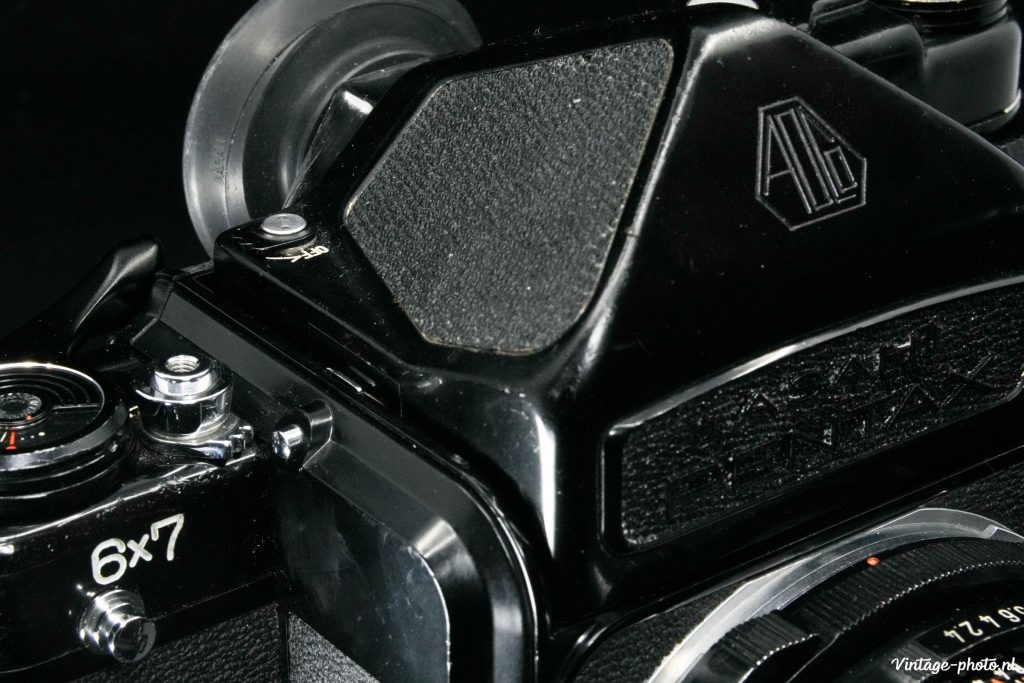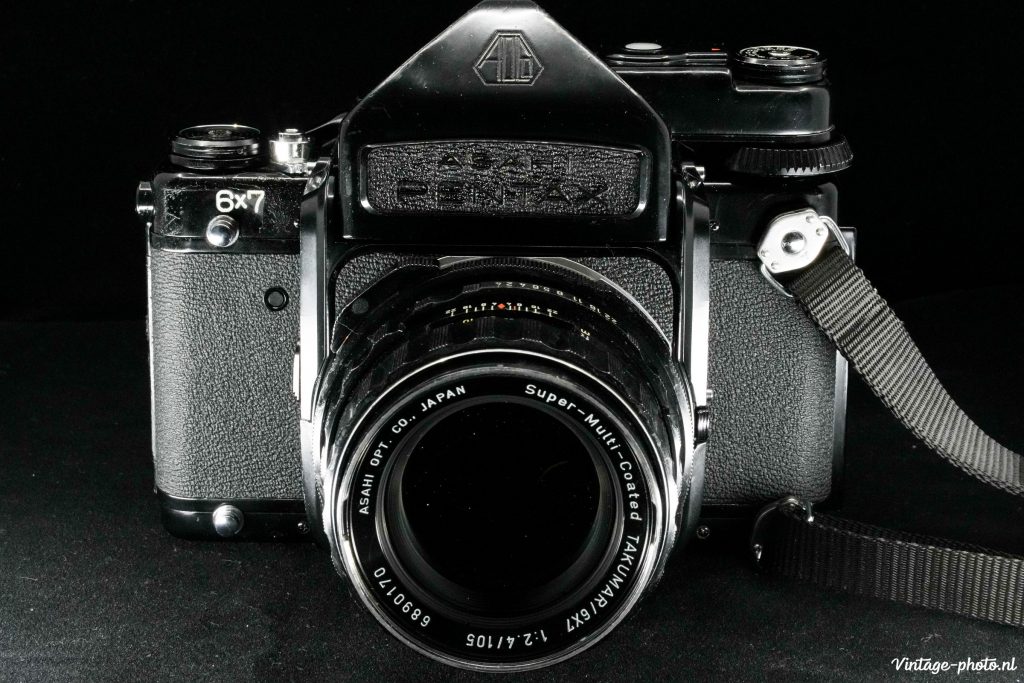If you shoot medium format, sooner or later you won’t escape the legendary Pentax 6×7. It is a mandatory camera in any serious collection. But above all, you take great pictures with it at 6×7 size, which is about 4x larger than a 35mm negative or a full frame sensor. The Pentax is the Japanese flagship in medium format. Big, heavy, noisy and expensive. But it’s also love at first sight (Updated review with examples).
I always dreamed of buying a Pentax 6×7 someday, but the prices scared me off. But as with other top brands, there is some sort of price guarantee. You sell the camera-if at all-for the same or better price. Think of it as an investment that pays off better than money in the bank. So it was time and I bought from Japan the Pentax MLU from about 1976. The cameras are really only for sale in Japan anymore. I let the first version 6×7 pass me by because it does not have a flip mirror, which is really necessary with these heavy cameras unless you are working on a tripod. The shutter and the clacking of the mirror can be heard for miles around. So not very useful when the bride and groom say “I do”.


However, the chance of motion blur is not high with this bulky camera. According to replies to this review and to my experience the so called ‘mirror shake’ is a myth. The mirror slaps back after the shutter has closed. The huge mass of the camera stabilises even longer exposures. A tripod however is recommended. My camera is from the second (of four) generations, the M(irror) L(ock) U(p) version. Other than that, it is similar to the classic. It is a medium format SLR camera, so very large. Smaller is also possible, but then you have to look for e.g. (Fujica) rangefinders without mirror or (Zeiss Ikon/Agfa/Voigtlander) bellows cameras. The latter do not have interchangeable lenses and the rangefinders usually have no focal plane shutter in the body, but leaf shutters in the lenses. In the SLR range only have the well-known German Pentagon 6 with 6×6 format, also an excellent camera with a large collection of excellent Zeiss lenses.


But the 6×7 format is special because of the rectangle, and yet not a 6×9 which is again very wide. A sympathetic intermediate format, so to speak. With a 120 roll you shoot 10 pictures, there is also a 220 setting but those rolls are no longer supplied. If you want to shoot many medium format pictures on a single roll, a 6×4.5 camera is better, by the way, also available from Pentax.


Everyone recognizes the Pentax 6×7 from its distinctive design, a chunky camera with large prism, a bloated SLR. A wooden handgrip is available to distinguish the camera from all others. Strangely enough, its only function is to make the camera easy to carry by hand. You cannot use the handle and focus and print at the same time. If so, it will actually get in the way. I have, despite the nostalgic value dispensed with the handle and instead put my money into a separate TTL prism, a good exposure meter that runs on the camera’s battery. A simple meter runs from – to +, but at the same time it does link the ASA setting and that is very handy.


Speaking of battery, the 6×7 feasts on easily available 4LR44 or 4SR44 batteries. The SR version is more stable and durable, but also costs more. The battery is used to flip the mirror, relax the shutter and move the shutter curtain. This is all big and loud, hence the battery needs to be changed regularly.


Speaking of battery, the 6×7 feasts on easily available 4LR44 or 4SR44 batteries. The SR version is more stable and durable, but also costs more. The battery is used to flip the mirror, relax the shutter and move the shutter curtain. This is all big and loud, hence the battery needs to be changed regularly. What exactly is possible with a single battery, I have yet to find out, but there are the wildest stories around. In any case, you should make sure that you do not use MLU function too often and certainly not for too long, this eats up power. The exposure meter is also eager for power, but you can turn it off immediately after the measurement. Without power, the camera does nothing. Nothing at all. It can also happen that the battery suddenly gives up, the mirror is still hanging halfway. Opening the battery compartment then offers a solution and then the special small button on the front to reset the mirror.


Without TTL prism, the camera is straightforward. On the right is the transport lever with image counter and shutter button. Also, the shutter can be locked with a small slide below the shutter button. On the right side is the 120/220 film button, which can now only be used in the 120 position for normal MF film. Left on the back is the battery check which illuminates a red light on top of the camera. Also on top is the shutter speed dial, ranging from a relatively fast 1/1000 (for medium format at least) to Bulb and flash sync at 1/30s. Between 1/1000 and X is a ‘blind’ time that allows for double exposures with a separate shutter release cable.
To the left and right of the prism are the release buttons to replace the prism or frosted glass. Be aware of the coupling between the prism and the lens. This coupling uses a chain that syncs the lens to the camera body. You have to remove a lens first before mounting the AE finder.


The viewfinder is large, but does not excel in clarity. Fortunately, Pentax already has automatic aperture control, allowing you to view with maximum aperture of the lens. You can also convert this to depth of field control by sliding the lensing into manual mode. The matte glass features a split screen circle in the middle for easy focussing. There is practically no other choice. There are other glasses, but difficult or impossible to obtain.


The real magic of the Pentax 6×7 is the legendary 105mm F2.4 lens. The reviews on the Internet are almost the same. Only in this combination do you have the best of the best. With F2.4 the (bit swirly) bokeh is defined as a gold standard for Pentax 6×7. The crop factor learns that this is a 50mm ‘standard’ compared to the 35mm format. The lens is sharp but focusses only from one meter onwards.


But there are many, many alternatives, from 35mm super wide angle to 1000mm super telephoto. The best reviews have the 55mm F4 and the 90mm F2.8 leaf shutter version. But there are more than 30 other lenses available and they all have in common that they are very good, partly due to the multi coating. They are also remarkably affordable, especially if you compare them with expensive Hasselblads. Conversion from the 6×7 format to 35mm can be found here and an overview of all compatible Pentax 6×7/67 Takumar SMC lenses here.


There are not many accessories available for the Pentax 6×7, except handles (left and right-handed), prisms (including with waist level viewfinder), flash units. That also means that you have what you need with the 6×7. A right handgrip is a plus to better operate the heavy camera. These are offered on eBay from plastic to wood. A carrying strap is also very useful, although it is better to carry the camera with your hand (yes, with the famous wooden grip). If you want to purchase a separate TTL prism, make sure that you get the adapter ring with it to place it on the shutter speed button! The Japanese offers are known for their high reliability, but do not forget to add the import duties to the price.
In a next review we will assess the image quality and the use of the camera in practice. Although for now it is already a joy to look at it and just hold the camera. If you want to read the manual in advance, you can do so here.


My first impressions are very positive, both in the use of “the beast” but certainly in the overwhelming quality of the photos. Of course, it is a heavy, but at the same time easy to operate camera. Focusing and exposure settings are like any other manual SLR. You will be approached on the street, because you do stand out with the 6×7. The photos from my test roll testify to the beautiful vintage color reproduction and the unprecedented sharpness of the 105 mm lens. There is hardly any difference with a very high resolution digital camera and indeed: you cannot reproduce such a gripping depth of field, bokeh and color digitally. Or you have to consult the filter box. However, the lens tends to chronic overexposure, it is advisable to underexpose this lens by 1 stop.









Good article! Two corrections:
– the mirror shake is a myth that everybody repeats. Not true. The mirror slaps back after the shutter has closed. I regularly shoot 1/15th and even 1/8th by hand and my photos are sharp. The huge mass of the camera stabilises it. Of course not with a telephoto lens, but with a normal lens.
– the chain: you only have to remove the lens before mounting the AE finder. Not when you remove it, and only the AE finder all the others are safe.
Cheers Olivier
Thanks Olivier for the useful remarks, i will edit them later in the text!
Really appreciate this comment, was able to find a pristine Pentax 6×7 with 105 lens but it’s non mlu body and was worried about the camera shake that I’ve been reading about . I was having buyers regret but it’s nice to know it’s not a big deal.
Very nice article. It relived the love for my Pentax 6×7!!
I have a question: I own one (MLU) with the Takumar 105mm and normal Prism. I’m thinking about selling it. What would you say it’s the approssimatively worth in good conditions, now in 2023 where the Film industry is getting more expensive?
Thank you in advance and many greetings from Germany!
Very useful article, thank you! I am travelling to Japan soon and plan to buy this camera. How much did you purchase it for and which shop/s do you recommend I check out?
Thank you!